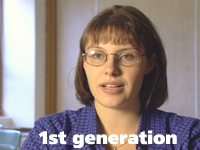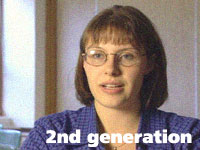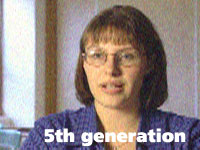|
Video
Recording > Generation Loss
|
Generation
Loss: Notice how the original VHS
(1st generation) image is sharp. The
copy (2nd generation) is a little
fuzzy, but still watchable. But the
copy of a copy of a copy of a copy
(5th generation) is an unviewable
mess.



|
|
|
Generation Loss:
You have probably experienced this with a Xerox machine:
The copy never looks as good as the original. And if
you make a copy of that copy, it looks even worse. It's
a similar story with analog VCRs.
For
example, if you make a copy a VHS movie, it doesn’t
look quite as sharp as the original. The original is
considered "1st generation," your copy
is called "2nd generation."
Now,
if you make a copy of that 2nd generation tape, you’d
be creating a 3rd generation copy, which will look even
worse!
This
problem of declining quality is called "generation
loss." The rate of generation loss varies with
each format—we will get into specifics a bit later.
But a general rule is this, copies made on analog VCRs
WILL have some generation loss—it can’t be
avoided.
The
good news is digital VCRs have NO generation loss. You
can make a copy of a copy of a copy and it will still
look identical to the original. In fact, when you copy
from digital tape to digital tape, we don't even call
the second tape a "copy." Instead, it's called
a "clone."

|